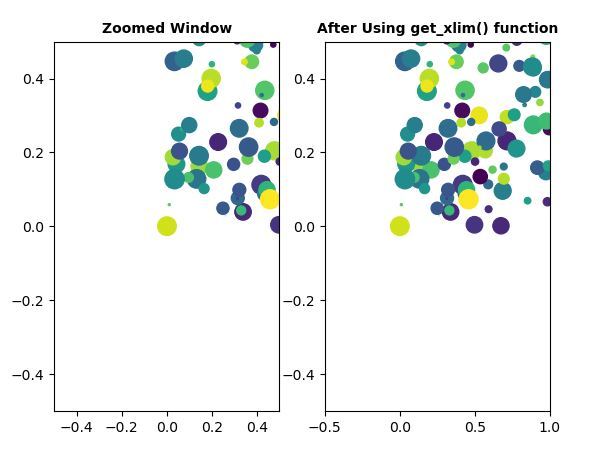Matplotlib es una biblioteca en Python y es una extensión matemática numérica para la biblioteca NumPy. La clase Axes contiene la mayoría de los elementos de la figura: Axis, Tick, Line2D, Text, Polygon, etc., y establece el sistema de coordenadas. Y las instancias de Axes admiten devoluciones de llamada a través de un atributo de devoluciones de llamada.
función matplotlib.axes.Axes.get_xlim()
La función Axes.get_xlim() en el módulo de ejes de la biblioteca matplotlib se usa para obtener los límites de vista del eje x.
Sintaxis: Axes.get_xlim(self)
Devoluciones: este método devuelve lo siguiente
- izquierda, derecha : Esto devuelve los límites actuales del eje x en coordenadas de datos.
Los siguientes ejemplos ilustran la función matplotlib.axes.Axes.get_xlim() en matplotlib.axes:
Ejemplo 1:
#Implementation of matplotlib function
from matplotlib.widgets import Cursor
import numpy as np
import matplotlib.pyplot as plt
np.random.seed(19680801)
fig, (ax,ax1) = plt.subplots(1 , 2 , facecolor='#A0F0CC')
x, y = 4*(np.random.rand(2, 100) - .5)
ax.plot(x, y, 'g')
ax.set_xlim(-3, 3)
xmin, xmax = ax.get_xlim()
ax.set_title('Original Window', fontsize=10, fontweight='bold')
ax1.plot(x, y, 'g')
ax1.set_xlim(xmin, 2*xmax)
ax1.set_title('Using get_xlim() function',
fontsize=10, fontweight='bold')
fig.suptitle('matplotlib.axes.Axes.get_xlim()\
Example\n',fontsize=10, fontweight='bold')
plt.show()
Producción:
Ejemplo 2:
#Implementation of matplotlib function
import matplotlib.pyplot as plt
import numpy as np
fig1, (ax1,ax11) = plt.subplots(1,2)
fig2, (ax2,ax22) = plt.subplots(1,2)
ax1.set(xlim=(-1.0, 1.0), ylim=(-1.0, 1.0),
autoscale_on=False)
ax2.set(xlim=(-0.5, 0.5), ylim=(-0.5, 0.5),
autoscale_on=False)
ax11.set(xlim=(-1.0, 1.0), ylim=(-1.0, 1.0),
autoscale_on=False)
ax22.set(xlim=(-0.5, 0.5), ylim=(-0.5, 0.5),
autoscale_on=False)
x, y, s, c = np.random.rand(4, 200)
s *= 200
ax1.scatter(x, y, s, c)
ax2.scatter(x, y, s, c)
ax11.scatter(x, y, s, c)
ax22.scatter(x, y, s, c)
def GFG(event):
if event.button != 1:
return
x, y = event.xdata, event.ydata
ax2.set_xlim(x - 0.5, x + 0.5)
ax2.set_ylim(y - 0.5, y + 0.5)
ax22.set_xlim(x - 0.5, x + 0.5)
ax22.set_ylim(y - 0.5, y + 0.5)
fig2.canvas.draw()
fig1.canvas.mpl_connect('button_press_event', GFG)
xmin, xmax = ax1.get_xlim()
ax1.set_title('Original Window', fontsize=10,
fontweight='bold')
ax11.set_xlim(xmin, 2*xmax)
ax11.set_title('After Using get_xlim() function',
fontsize=10, fontweight='bold')
xmin, xmax = ax2.get_xlim()
ax2.set_title('Zoomed Window', fontsize=10,
fontweight='bold')
ax22.set_xlim(xmin, 2*xmax)
ax22.set_title('After Using get_xlim() function',
fontsize=10, fontweight='bold')
fig1.suptitle('matplotlib.axes.Axes.get_xlim() \
Example\n',fontsize=10, fontweight='bold')
plt.show()
Producción:

Publicación traducida automáticamente
Artículo escrito por SHUBHAMSINGH10 y traducido por Barcelona Geeks. The original can be accessed here. Licence: CCBY-SA